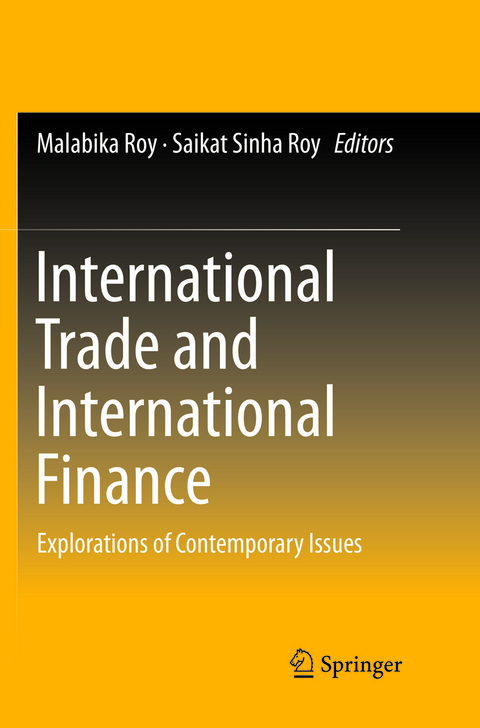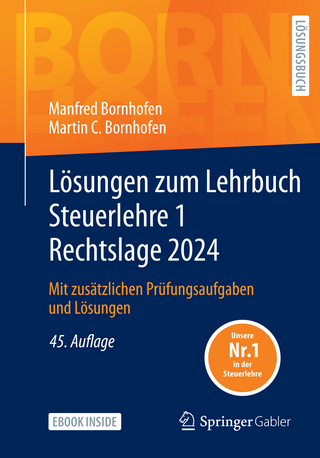
International Trade and International Finance
Springer, India, Private Ltd (Verlag)
978-81-322-3840-9 (ISBN)
Malabika Roy is a faculty member of the Department of Economics, Jadavpur University, Kolkata. She teaches financial economics to the undergraduate as well as the post graduate students. Her research interest includes corporate finance, financial markets in emerging economy and understanding the role of financial markets and institutions at the household level. She has widely published in reputed national and international journals. She has also conducted several research projects funded by national and international agencies and has worked as consultant for UN, ESCAP. Saikat Sinha Roy is a faculty member of the Department of economics, Jadavpur University, Kolkata. His research interest and teaching are focused on theories and empirics of international trade, applied trade modeling, and interface between trade and industrial structure, international trade and institutions. He has published in reputed national and international journals. He received the prestigious British Academy of Social Sciences/ESRC/AHRC Visiting South Asia fellowship in 2009. In 2013 he received a research grant from British High Commission, New Delhi, to conduct a study on state level exports in India. He also conducted the UNCTAD-GoI-DfiD funded Trade Related Research Capacity Building project.
Part 1: Recent Developments in Trade Theory and Empirics.- Chapter 1. The “New-New” Trade Theory: A review of the literature.- Chapter 2. Time Zones and FDI with Heterogeneous Firms.- Chapter 3. Firm Heterogeneity and Decision to Export: An exploration with India’s Capital Goods Sector.- Chapter 4. IPR Regulatory Policy, Commercial Piracy and Entry modes of MNC: A Theoretical Analysis.- Part 2: International trade and institutions.- Chapter 5. International Trade and Size of the Government.- Chapter 6. Heterogenous Effect of Corruption on Bilateral Trade: Sectoral Gravity Analysis with Panel Data.- Chapter 7. Enlargement Decisions of Regional Trading Blocs.- Chapter 8. The Deal Breaker or the Protector of Interests of Developing Countries: India’s Changing Negotiating Stance in WTO.- Part 3: Issues in Trade, Trade Policy and Development.- Chapter 9. Export Performance in Textile and Garments with China as a Competitor: An analysis of India’s situation from the perspective of Structure-Conduct-Performance paradigm.- Chapter 10. Impact of Trade Liberalization on Indian Textile Firms: A Panel Analysis.- Chapter 11. Trade, Infrastructure and Income Inequality in Selected Asian Countries: An empirical analysis.- Chapter 12. A Theoretical Model of Trade, Quality of Health Services and Signalling.- Chapter 13. Smuggling and Trafficking of Workers: A brief review and analysis of the Economics of Illegal Migration.- Chapter 14. Impact of Trade vs Non-Trade Policies on the Incidence of Child Labour: A Two Sector General Equilibrium Framework.- Chapter 15. FDI and Child Labour in a Developing Economy: A General Equilibrium Analysis.- Part 4: Issues related to foreign investment flows.- Chapter 16. The Role of Institutions in Attracting US FDI.- Chapter 17. Does foreign direct investment promote capital accumulation?.- Chapter 18. Do macroeconomic indicators influence foreign direct investment in India? A Causality Analysis.- Chapter 19. The Nature of trading by Domestic and Foreign Institutional Investors: A Cross Country Analysis.- Part 5: Issues relating to Globalization, financial markets and financial instruments.- Chapter 20. Exploratory study of select commodity and equity index around 2008.- Chapter 21. An empirical estimation of volatility clustering, volatility spillover and persistence in terms of half-life from a developed country USA to two emerging economy India and China.- Chapter 22. Post Crisis Global Financial Architecture and India.- Part 6: Issues related to foreign exchange market.- Chapter 23. Survey and benchmarking of Indian FX markets and types of intervention.- Chapter 24. The global foreign exchange market: crisis and beyond.- Chapter 25. ‘The Impossible Trinity’: Where does India stand?.- Part 7: Issues related to financial institutions.- Chapter 26. Insuring the Insurer: a game theoretic approach to regulatory design.- Chapter 27. Does skill matter in Mutual funds? How emerging markets differ from more developed markets/Mutual fund performance: An International Perspective.- Chapter 28. Determinants of foreign bank entry into emerging market economies.- Chapter 29. Banks, financial derivatives, and crises: a fourth generation model.
| Erscheinungsdatum | 27.08.2018 |
|---|---|
| Zusatzinfo | 59 Illustrations, color; 20 Illustrations, black and white; XVI, 595 p. 79 illus., 59 illus. in color. |
| Verlagsort | New Delhi |
| Sprache | englisch |
| Maße | 155 x 235 mm |
| Themenwelt | Wirtschaft ► Betriebswirtschaft / Management ► Finanzierung |
| Wirtschaft ► Volkswirtschaftslehre ► Finanzwissenschaft | |
| Wirtschaft ► Volkswirtschaftslehre ► Makroökonomie | |
| Schlagworte | Emerging Markets • Foreign Direct Investment • Foreign Exchange Market • Foreign Institutional Investor • International finance • International Trade and Institutions • Recent Trade Theory • trade and development |
| ISBN-10 | 81-322-3840-0 / 8132238400 |
| ISBN-13 | 978-81-322-3840-9 / 9788132238409 |
| Zustand | Neuware |
| Haben Sie eine Frage zum Produkt? |
aus dem Bereich


